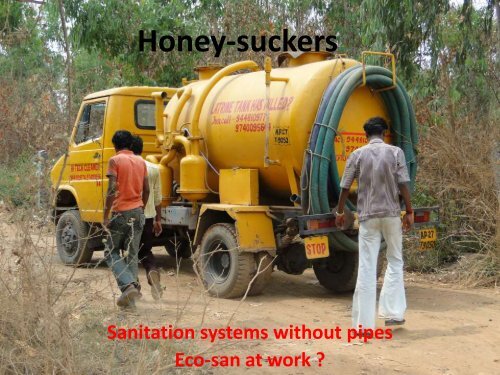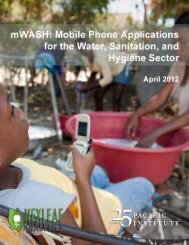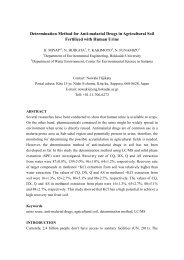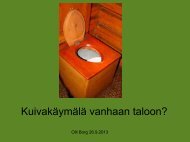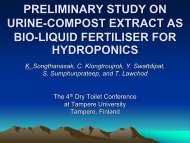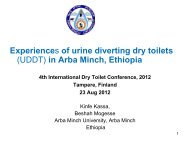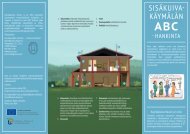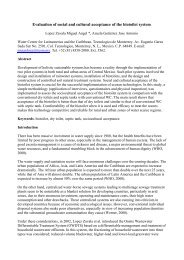Honey-suckers
Vishwanath Srikantaiah et al
Vishwanath Srikantaiah et al
You also want an ePaper? Increase the reach of your titles
YUMPU automatically turns print PDFs into web optimized ePapers that Google loves.
<strong>Honey</strong>-<strong>suckers</strong><br />
Sanitation systems without pipes<br />
Eco-san at work ?
Partially based on a research<br />
Sludge Reuse from Mega-Cities – A<br />
Southern India Case<br />
Elisabeth Kvarnström, Vectura Consulting, Inc.<br />
Joep Verhagen, IRC<br />
Mats Nilsson, MN Context<br />
Vishwanath Srikantaiah, Biome (responsible for this slide show)<br />
Karan Singh, Biome<br />
Shubha Ramachandran, Biome
Bangalore – Population 9 million
Septic tanks and Pit Latrines<br />
India has 102 million septic tanks or<br />
pit latrines . (National Family Health<br />
Survey, 2006)<br />
India has more than 68 million single<br />
pit or double pit toilets in rural areas<br />
(ddws.nic.in 2012)<br />
This represents a massive sludge<br />
management challenge
Current Drivers of Sanitation<br />
The employment of Manual Scavengers and Construction of Dry<br />
Latrines (Prohibition) Act 1993<br />
• Karnataka has adopted this Act in 1997<br />
• All toilets should have a water seal of at least 20cm.<br />
• No removal of human waste by human hands
Bangalore urban and sanitation<br />
• No. of Households 2,377,056<br />
• HH’s having toilets 2,254,599<br />
• Piped sewer system 1,715,904<br />
• Septic Tank 169,046<br />
• Pit toilets 325,175<br />
• Total 494,221<br />
• Source : Census of India 2011
The city utilities response<br />
• Only 400 MLD out of 1000 MLD sewage<br />
generated is collected<br />
• Of the 400 MLD collected only around 180<br />
MLD is treated<br />
• Sanitation is subsidized. People pay Rs 15 a<br />
month for sewage connection charges<br />
• The externality is pollution of rivers
Foam rivers<br />
Untreated sewage primary cause
From untreated sewage
The informal sector in urban sanitation
Pre-cast concrete rings
In informal vacant sites
Pit toilet connected to WC
The user interface remains conventional
Pit toilets are common in the urban<br />
periphery
The <strong>Honey</strong>sucker vacum sucks a pit<br />
toilet
Mechanization eliminates manual<br />
scavenging
Trucks are now indigenously<br />
developed
They have a water jetting and vacum<br />
sucking pump (upto 30 H.P.)
Assembling a honey-sucker
The barrels – informal sector body<br />
building works
All over the country –<br />
Mobile Technology
Mobile technology
We estimate nearly 300 honey-<strong>suckers</strong><br />
in Bangalore
Protocol for safe disposal needs to be<br />
evolved
The sewage is nutrient rich but also<br />
pathogenic
Cost to building Rs 1200/ to Rs 3000/
Soil as a nutrient recipient rather than<br />
water
In many apartments a daily visit
In the most expensive of buildings
Behind the bushes
BWSSB (Guidelines for discharging domestic waste water from soak pits/<br />
mobile toilets into Board Sewers in the premises of BWSSB STP)<br />
• Non refundable deposit amount equivalent to 6 months as<br />
indicated by the applicant at the rate of Rs 50/kl<br />
• Rs 50/kl charge per month<br />
• Domestic wastewater which will be disposed to the Board<br />
sewer in the premises of STP shall comply for BWSSB<br />
standards fixed for discharging trade effluent<br />
• Till now 75 permits have been issued for 1mld. ( Contrast with<br />
494,221 households having septic tanks or pit toilets.)
The informal sectors response
The composting (?) pit
Diluted grey-water
Compost sells for Rs 2500/- to Rs 3500/- a<br />
tractor load (4 cu mt)
Compost sample being collected for<br />
testing
Fertilizer value of sewage sludge<br />
Kind of Nutrient<br />
1000 kg of sewage sludge<br />
(10% TS) grams<br />
Average nutrient content in<br />
N 5.5 17.5<br />
P2O5 17.5 17.5<br />
K2O 0.75 65<br />
S (Total) 12.5 25<br />
MgO 30 15<br />
Cu (Total) 1.2 0.03<br />
Zn (Total) 1.5 0.15<br />
Mn (Total) 0.6 0.4<br />
Mo (Total) 0.01 0.001<br />
B (Total) 0.03 0.035<br />
1000 kg of farm yard<br />
manure grams<br />
Source: Ludwig Sasse, BORDA, 1998, DEWATS Decentralised Wastewater Treatment in Developing Countries
The city moves in
Application on banana
The crop
The fruits
The soil – alive with alive with<br />
earthworms and ants
Humanure for Arecanut
The Economics<br />
For the truck<br />
• A <strong>Honey</strong>sucker costs Rs 800,000 /-<br />
• Charges Rs 1500 / per trip<br />
• Can do 5 trips in a day<br />
• Income Rs 7500 a day Rs 225,000 a month<br />
• Income in a year Rs 2.7 million<br />
• Expenditure for O and M - Rs 400,000<br />
• Simple Return on Investment 6 months<br />
• One truck can service a population of 20,000<br />
assuming a 2 year pit emptying cycle
The Economics<br />
for the household<br />
• Rs 1500 / every 2 years<br />
• Rs 60 / a month approx<br />
• Rs 15 a month if you are connected to the<br />
sewage
• Free compost<br />
The Economics<br />
for a farmer<br />
• On labour - expenditure Rs 5000 /<br />
• Savings per acre Rs 20,000 to Rs 50,000 /- on<br />
manure alone (10 to 25 tractor load per acre<br />
per year )
Land required to absorb nutrients<br />
• 250 tanker loads per Hectare<br />
• 2500 peoples nutrients can be absorbed by 1<br />
Hectare of land<br />
• 50000 population town needs 20 Hectares of<br />
land<br />
• 100,000 - 40 Ha.<br />
• 1 Million 400 Hectares
Way forward…<br />
• Better understanding, from a business and<br />
sanitation perspective, of existing practices<br />
around the country<br />
• Embedding of current practices as an officially<br />
accepted option to sanitation service delivery<br />
for all urban dwellers
Way forward<br />
• Developing a protocol for the inclusion of nonsewerage<br />
based or on-plot sanitation systems in<br />
India<br />
• Developing a protocol and a legal frame-work for<br />
handling, transportation, composting and<br />
application of nutrients from septage and on-plot<br />
systems<br />
• Research on understanding nutrient – pathogens<br />
and safe application for nutrient reuse
Way forward<br />
• Civic authorities to incorporate sewage<br />
disposal systems in building plan approvals<br />
• Land use plans to earmark space for solid and<br />
liquid waste composting .<br />
• Separate systems for toilets and grey-water<br />
• Understanding the pit / groundwater interface<br />
and designing systems for non-pollution.
Guidelines for the safe use of<br />
wastewater, excreta and grey water<br />
Cost-effective strategies for controlling negative health impacts<br />
• Treatment of wastewater, excreta and greywater is used to prevent the contaminants<br />
from entering the environment.<br />
• Crop/produce restriction is used to minimize health risks to product consumers.<br />
• Waste application techniques (e.g. drip irrigation) and withholding periods aim to reduce<br />
contamination of the products or allow sufficient time for pathogen dieoff in the<br />
environment prior to harvest.<br />
• Exposure control methods (e.g. protective equipment, good hygiene) will prevent<br />
environmental contamination from reaching exposed groups.<br />
• Produce washing/rinsing/disinfection and cooking reduce exposures for product<br />
consumers.<br />
• Vector control reduces exposures for workers and local communities.<br />
• Chemotherapy and immunization can either prevent illness for those who are exposed or<br />
treat those who are ill and thus reduce future pathogen inputs into the wastewater,<br />
excreta or greywater.<br />
Source: WHO 2006
Thank you!<br />
zenrainman@gmail.com


